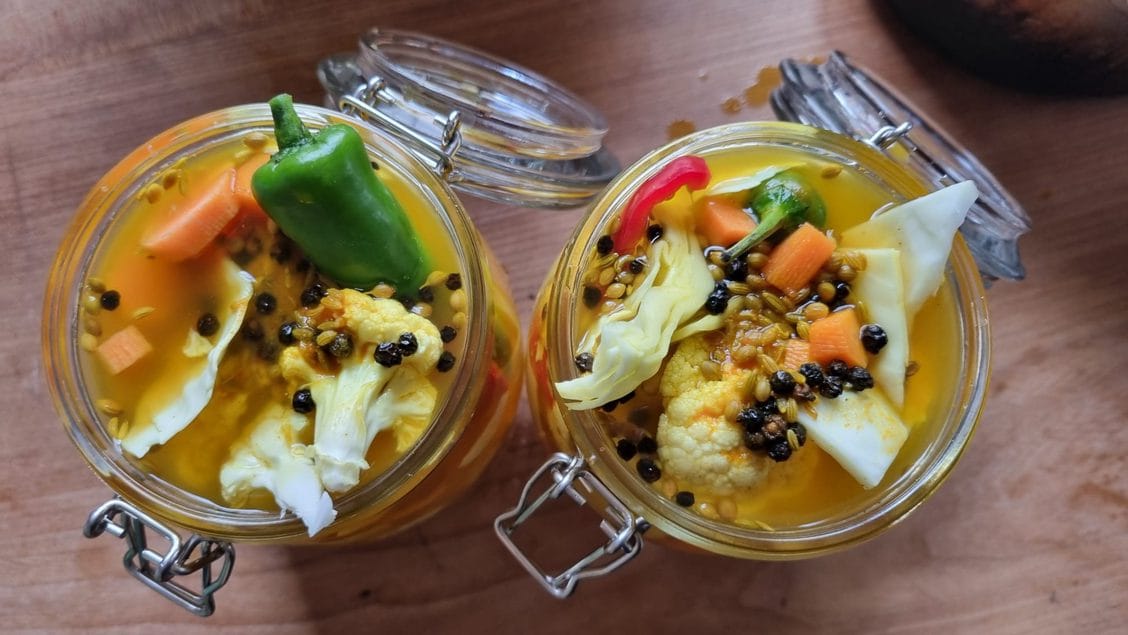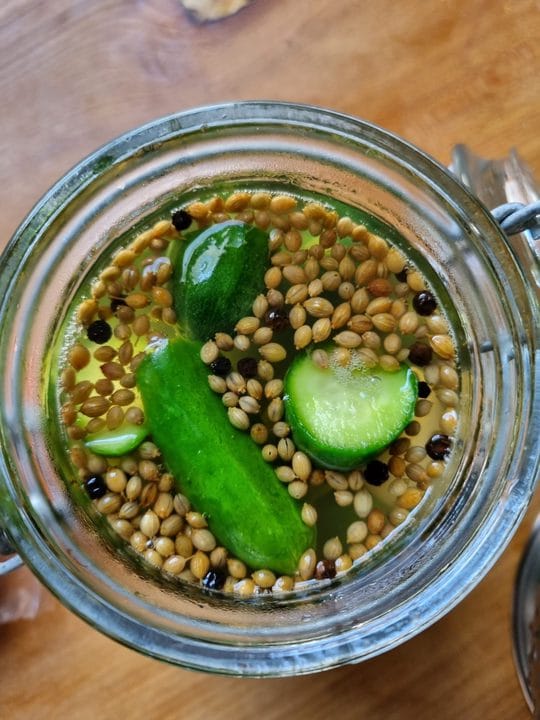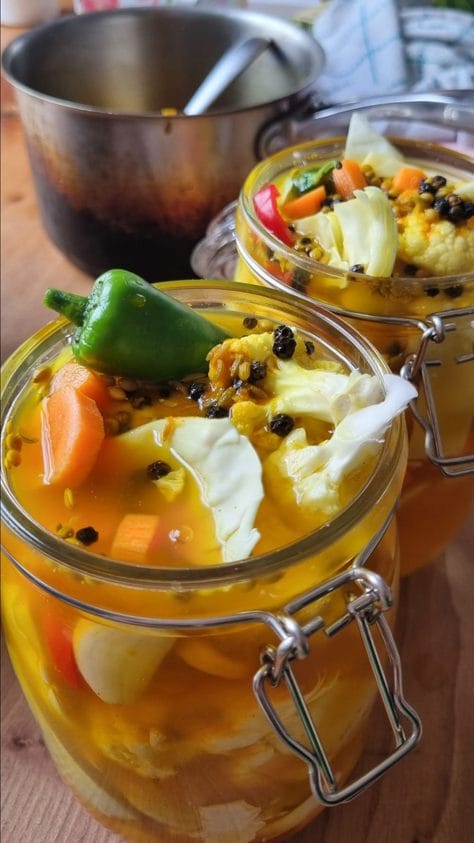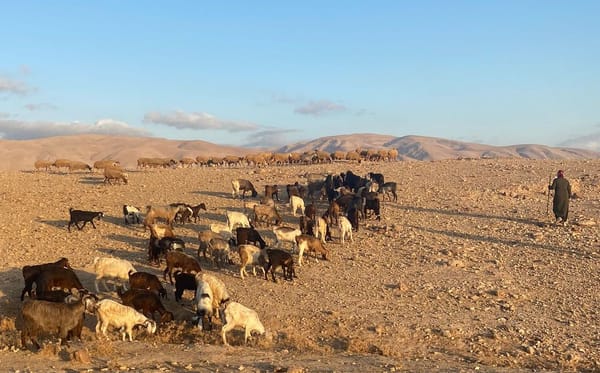Finding trooshi
The Sephardi pickle time forgot.

I come from a Turkish Sephardi family – native Ladino speakers, the whole shebang. We ate pickled vegetables regularly when I was growing up. I remember as a child in our Israeli Toronto home reaching into the fridge for crisp cauliflower, spicy red peppers, sour cabbage. Turnips, pink and crunchy, jarred with beetroot by our Egyptian friend Emil, which we would finish as soon as they arrived in our kitchen. My younger sister and I would fight for the last cauliflower or hot pepper in a jar of khamootzim [khamootz is Hebrew for sour], as these pickles are called in Israel.
A few months ago, I thought it might be fun to write a pickle-themed piece for readers of The Pickle. Never mind that pickling scares me, that all fermenting seems a bit crazy given the risks involved in growing bacteria and then eating it. But I didn’t want just any pickles, I wanted the Sephardi pickles I ate as a kid. I asked my 94-year-old aunt Alegra in Israel what these pickles, which she also ate in Turkey as a kid, are called. Trooshi, she said. I’d never heard of them, though I had apparently been eating them my entire life.
I began my search for trooshi, this Sephardi and Mizrachi pickle, by asking my family if they had any memories, recipes or stories about khamootzim. Only my mum – the [sole] Ashkenazi of the bunch – had a clear and thorough method for making them. Leaving aside for a minute that her own grandmothers were Turkish and Egyptian, this felt inauthentic. I kept searching.
My hunt for trooshi continued with my paternal cousin Doron in Israel, who used to own a restaurant in upscale north Tel Aviv. “Trooshi? I think you mean churshi,” the a Tunisian salad made with pumpkin. This seemed way off. I asked him if he had a recipe for khamootizim and only got a vague method: put vegetables in a jar with salt, garlic and spices. This seemed too risky; I needed further instruction.
An aunt and distant cousin offered up their own methods for trooshi. The cousin’s was this: fresh cucumbers, wash them well, put them in a jar, add about a tablespoon of salt per kilo of cucumber (approximately), chilli pepper if you like it spicy. Add peeled garlic and top with dill. Close the jar for a few days until it sours and that’s it – beteyavon [bon appetit in Hebrew].
I felt I was getting somewhere with this, until I read Claudia Roden’s recipe for turshi; she says to boil the water with salt and add vinegar. My family didn’t mention anything about boiling. Was I going to kill my diners if I didn’t first boil the pickling juices?
Whilst instructive, none of these recipes came with the memories of TurkeyI’d hoped for; they foated in a vacuum.
Jews from the SWANA region – South West Asia and North Africa – their languages, liturgy, culture – have been heavily marginalised both by the Israeli state and across the diaspora. Marginalised to the point of forgetting. We have forgotten that for centuries, Jews and Arabs lived in al-Andalus, Baghdad, Tehran, Istanbul; that Jewish people have given their children Arabic names; that they’ve sung their prayers to Spanish tunes.
Our foodways have been similarly forgotten.
This is changing. The study and practice of reviving Mizrachi and Sephardi food is a growing area. Many are turning family recipes into cookbooks and memoirs – people like Viviane Bowell in Bristol, who set out to chronicle her family’s food history and ended up self-publishing two books based on them. Scholarly efforts include Helene Jawhara Piner’s, historian and author of the award-winning Sephardi: Cooking The History.
Since turning to the anthropology of food about two years ago, after over 15 years of writing about the politics of reproduction and Israel-Palestine, I’ve been researching my family’s food history and traditions, trying to bring them to life. A mixture of migratory histories, the rise of social media, Mizrachi fetishism in Israel and Ashkenormativity in the diaspora have made this a slow process at times: family members provide contradictory stories; recipes and entire hand-written notebooks of recipes have gone missing. Instead, people send me down YouTube rabbit holes or refer me to obscure Facebook groups.
Researching this piece, I felt repeatedly frustrated with my family’s lack of detailed stories of mothers making pickles and the fact I couldn’t find trooshi. Online, all I could find was turshi.
Turshi is an Iranian word for pickled vegetables that are lacto-fermented (salt, spices and water in an airtight environment). One of the oldest forms of food preservation, archaeologists believe this form of pickling vegetables emerged from Mesopotamia around 3,000 years ago. They are well known in the region and have an almost identical pickle in Turkey called turşu.
Meanwhile, trooshi is the Turkish Sephardi word referring to all pickles that are lacto-fermented. Turshi and trooshi are remarkably similar, but the latter is generally made without the extra spices; just salt, herbs, garlic and sometimes chilli. Whilst you can have any kind of vegetable, in our tradition it’s generally cucumbers or mixed vegetables such as cabbage, cauliflower, carrots and turnips. This more Turkish-influenced version of the pickles I ate growing up is milder in flavour than the one you might find in Iran, Iraq or Israel for that matter, where turshi became known as khamootzim that are stuffed into falafel at most local food stalls.
Though they were generous with methods, no one in my family could help me recover the history of trooshi, so I turned to my Mizrachi community here in Bristol, as well as to social media and cookery books.
The first thing I kept getting told I was saying it wrong: it’s not trooshi, it’s turshi.
Why does my family all say it wrong? More forgetting.
In Ladino, some people in an online food forum reminded me, letters in words borrowed from other languages often get switched around. Gordo ( an affectionate word in Spanish literally meaning “fat” but is in fact a term of endearment) became godro, turshi (or tursu as it’s called in Turkey) became trooshi. I discovered other Turkish Sephardim also call it trooshi, not turshi. Whilst having local variations across the SWANA region, and within different communities, trooshi seems to be part of a wider regional, historical approach to food preservation. Maybe the pickles I ate growing up were Sephardi in their name, but regionally identical to the ones eaten by non-Jews in the Muslim majority countries in which they lived.
So after asking many members of my extended Sephardi family for memories of trooshi, I found only snippets I’ve had to piece together. “Put vegetables, whatever you like, in a jar, with salt and maybe vinegar, and maybe a hot pepper” and “Ah yes, my mother always had them on the shelf”. My search for trooshi led to a cul de sac. Maybe there was nothing to tell. Or maybe migration is to blame.
The histories of families like my own have involved much movement and settlement over centuries. We speak and have always spoken Spaniyolit (Ladino). And while our agreed-upon family history is that we came from Spain, a large portion of my family came from Italy to Salonica (modern-day Thessaloniki, Greece) as it was called under the Ottomans. My ancestors resided there for centuries until rising ethnic nationalisms in Europe led to the expulsion of Greeks from Turkey, many of whom fled to Salonica, whilst many Jews – including my ancestors – left Salonica for the Eastern Dardanelles in Turkey). My great-grandparents lived in Canakkale, the nearest place to the ancient city of Troy, and then in Bayramic about 70km away.
They were wine-growers, bakers and fabric sellers. Turkish wine was incredibly important to Europe in the late 19th and early 20th centuries as an epidemic of phylloxera (a tiny aphid) brought over to France from American vineyards killed off most of Europe’s vineyards, making Turkey one of the biggest suppliers of wine to Europe at that time. My winemaking great-grandparents the Bardavids were said to be some of the wealthiest winemakers in the town.
These Italian and Salonican roots have been all but forgotten by younger generations, only my aunt and an older cousin have been able to help me discover these details. I have had to really push older relatives to tell me more, and research the histories of the places where they lived. In 1917 the Great Fire of Salonica burned down most of the city and left approximately 70,000 people homeless. The Jews migrated out of Salonica towards various parts of the Eastern Dardanelles, now part of Turkey. Turkish Jewish families sent their sons to America to avoid conscription to wars in the late 19th and early 20th centuries; approximately 1.2 million Jews from the Ottoman empire migrated to America between 1864 and 1914.
With rising nationalism in 1930s Turkey, life for Jews became unliveable: the 1934 Thrace pogroms saw violent attacks against Jews and their businesses. The Turkish wealth tax, introduced in 1942, in an apparent bid to raise funds for Turkey to enter the war, impoverished many, including elite Jewish families. Approximately 34,000 Jews migrated to Israel between 1948-51, including nearly 40% of Turkish Jews, my family among them. They were not received with open arms.
As the historian Orit Rozin has shown, the Israeli state used food as a way of disciplining Sephardi and Mizrachi arrivals. Their traditional foodways were portrayed as insufficiently nutritious; mothers were accused of eating their children’s rations, fathers of squandering food money on alcohol. Public health workers were assigned to supervise Mizrachi mothers feeding their children.
The difficulty of my search for trooshi makes sense in light of this history. I’ve had to piece together lost traditions to construct a new one.
In the end, my pickles fused memory and text, history and improvisation: I looked to Linda Dangoor’s Flavours of Babylon, Claudia Roden’s Book of Jewish Food, Yotam Ottolenghi and Sami Tamimi’s Jerusalem, my relatives’ extremely brief comments and my mother’s careful step-by-step guidance over the phone from Canada.
The result was pure nostalgia: crunchy, tart, and as flavoursome as the pickles of my childhood, but now injected with new tastes from the past. I made two kinds of trooshi: one just with cucumber; another a mixture of mine and my sister’s favourites: cauliflower, carrots, cabbage and peppers.
Here’s what I did.
Prep for both recipes
Sterilise a large Kilner jar by washing it well with soapy water and rinsing. Take off the rubber seal and place in a bowl with just boiled water from the kettle. Place the jar into the oven at around 100℃ for at least 10 minutes. Take out and leave on the counter. Air dry the rubber seals.
Cucumber trooshi
Mix a litre of water and four tablespoons of sea salt in a pan and bring it to a boil, adding 1 tablespoon peppercorns and 1 tablespoon coriander seeds until the salt is dissolved. Then add 300ml apple cider vinegar.
In the sterilised jar, stuff as many (well-washed) mini cucumbers as fit, plus a few garlic cloves.
Pour the liquid over the cucumbers, close the top and leave to cool before sealing. Once cooled, seal it shut and put it on a sunny shelf for three days. After that, refrigerate.

Mixed vegetable trooshi
I used the same process for the jar and pickling liquid, adding a tablespoon each of turmeric and fennel seeds.
Chop a head of cabbage, a head of cauliflower (removing the leaves and setting them aside for use in something else – no food waste here!), a few carrots and a couple of small red and yellow sweet peppers. Added to two large Kilner jars, stuffing in a whole chilli pepper and garlic at the end. Let them cool, then seal and place on a sunny window for three days. Once you open them, refrigerate. These will keep in the fridge for about two months.

Michal Nahman is an anthropologist at UWE Bristol and founder of the Mizrahi Food Project.




